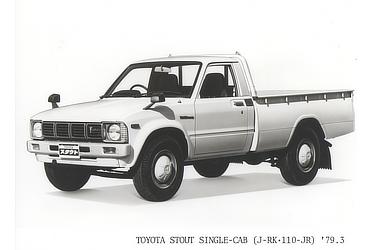Mar. 07, 1979
TOYOTA STOUT UNDERGOES FULL MODEL CHANGE
First in Nearly 19 Years
TOKYO―Toyota Motor Co. and Toyota Motor Sales Co. jointly announced on March 7 the nationwide introduction to the domestic market of a full model change of the Stout, a bonnet-type light truck. This is the first such change made in the Stout since June 1960.
The new Stout is available in three models―two single-cab types and one double-cab type―all mounted with the 5R Type 1994cc engine. The Stout's high performance and outstanding carrying characteristics have been improved still further, with an emphasis on styling, greater safety and durability and an improved cabin interior aimed at passenger-car comfort.
The following are the main areas in which improvements have been introduced in the Stout.
-
- New styling
- The use of dual-lamp headlights and a more spacious front windshield lets the Stout retain its image of a tough, sturdy truck, while the double-cab type now has four doors instead of three, making for greater ease of use.
-
- Compliance with 1979 emissions and noise standards
- Japan's tough domestic emissions standards have been met without any loss in engine performance, made possible through improvements in ignition timing and deceleration controls. Noise control standards have been met mainly by using a higher capacity muffler and a temperature controlled fluid coupling fan.
-
- Increased durability and stability
- Strengthened axles in front and rear have made riding characteristics more stable. And in order to provide greater durability in both tough driving and adverse environmental conditions, changes have been introduced in the Stout's body construction at the same time that various corrosion-proofing measures have been introduced―such as the use of rustproof steel plating and of rust preventative in key places. As an added convenience the fuel tank capacity has been raised from 40 liters to 61 liters, thus allowing longer periods of driving without refueling.
-
- Increased safety
- A large-size brake booster used in the single-cab type improves braking performance, and a Load-Sensing Proportioning Valve―standard in all model types―allows adjustments in the braking force according to actual truck load and provides a stable braking performance in emergencies.Greater glass area gives the driver a wider field of vision, and improved window wipers clean a wider glass area in rain and snow.Other safety factors include continuous-webbing 3-point type seatbelts for easier fastening and unfastening. Also, corrugated tubing is used in the electrical circuitry, and more fuses are used, to give most electrical items their own fuse.
-
- Greater comfort and improved equipment
- The wider, longer cabin interior gives the Stout greater roominess, enabling the seats to now slide a total of 140mm instead of 100mm, and the seat backs to recline up to 24 degrees instead of 17 degrees: these improvements make the driver's seating position more comfortable.Several other improvements contribute to giving the Stout both functions and comfort usually found only in passenger cars; they include a trip-meter, triple-outlet air condilation and integrated switches. The cabin has a suspended ceiling which is both ventisome and designed for a maximum in noise-reduction and heat proofing.





